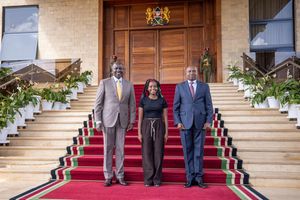
SBM Bank and Kingdom Bank were charging the highest interest rates on personal loans by the end of last year, making them the most expensive banks in Kenya, according to the latest data from the Central Bank of Kenya (CBK).
Kingdom Bank, a subsidiary of the Co-operative Bank of Kenya, had the most expensive overdraft facility on personal loans, priced at 15.2 percent on average, followed by Ecobank which was charging interest at 14.7 percent on overdrafts. They were followed by Gulf African Bank (14.4 percent), Middle East Bank (14.3 percent) and Guardian Bank (14.1 percent), according to the data covering the quarter ending December 2023.
On its part, SBM had the costliest personal loans for tenors between one and five years, having charged customers 19 percent interest rates.
Sidian Bank and I&M Bank had the second costliest loans with tenors of between one and five years at 18.3 and 18.8 percent respectively while Absa Bank Kenya, Credit Bank and Housing Finance priced loans of similar duration at 17.7 percent each at the end of last year.
SBM was also the most expensive lender for loans with tenors surpassing five years after it charged 18.6 percent, followed by Absa and Housing Finance Company at 16.9 percent each, UBA Bank (16.7 percent) and Habib A.G. Zurich (16.5 percent).
On the flipside DIB, Bank of Africa, Housing Finance, Consolidated Bank of Kenya and DTB had the lowest cost of personal overdraft loans in December last year while Premier Bank had the lowest interest rate on both mid- and long-term facilities.
Premier Bank charged 9.0 percent for personal loans with a repayment period between one to five years, making it the cheapest bank in the period under review. It was followed by Ecobank (9.9 percent) and Access Bank (11.3 percent). DTB and Kingdom Bank came in fourth in the ranking of cheapest banks for the period, charging customers 11.4 percent for personal loans under five years.
The cost of servicing personal, business and corporate loans rose significantly across 2023 as the CBK raised its benchmark interest rate to rein in inflation and halt the depreciation of the Kenya shilling. The period was also characterised by higher returns on government securities and fixed deposits, with the latter raising the cost of funds for banks.
“Commercial banks’ average lending and deposit rates increased in the second half of 2023 in line with the tightening of the monetary policy stance. The weighted average lending rate increased to 14.64 percent in December 2023 from 13.31 percent in June 2023, while the weighted average deposit rate increased to 10.1 percent from 7.8 percent in June 2023,” the CBK states in its latest monetary policy statement.
At the same time, commercial banks began implementing the risk-based loan pricing models more broadly in the second half of 2023, resulting in an uptick in interest rates for riskier borrowers. At the start of June last year, the CBK indicated it had given the nod to 33 out of 38 banks to set interest rates for borrowers based on their different risk profiles.
The raising of interest rates by the CBK has, however, been the primary driver of higher interest rates on commercial bank loans with lenders having followed up the rate increases with adjustments to their base lending rate.
For instance, Equity Bank lifted its loan reference rate from the previous 17.56 percent to 18.24 percent, setting interest rates on its riskiest borrowers to highs of up to 26.74 percent effective last month.
The move, which has been replicated across the industry, followed the February 5 decision by the CBK to lift the benchmark lending rate further to 13 percent from the previous 12.5 percent.
Both the CBK and commercial banks have managed to increase interest rates without dampening credit growth to the private sector while the banking industry asset quality has improved slightly despite pressure from increased borrowing costs.
Working capital requirements have kept up with the demand for credit even as borrowers face multi-year high loan costs. Average interest rates on overdraft facilities –loans with tenors of less than one— rose the highest by 2.41 percentage points between January and December last year while those on facilities exceeding five years rose slower at 1.5 percent, according to the CBK data.
“Credit to the private sector remained resilient in the second half of 2023, growing by 13.9 percent in the 12 months to December 2023 compared to 12.2 percent in the year to June 2023. This partly reflected credit demand for short-term working capital requirements arising from increased input costs,” the CBK added.
The cost of overdraft loans is easily reset upwards based on the short-term nature of the facilities and their high churn rate.









